
views
Planning Your Topic

Do your research. The first step to writing any article is to research your topic. Whether you have been assigned a topic or you are choosing it for yourself, you need to find out everything there is to know about your topic. The right kind of research for you will depend upon the kind of article you are writing, For example, if you are writing a news article, you will probably want to get out there and interview people who are related to the story. If you are writing about fitness trends, however, you may be able to do all of your research online. When doing research, be sure to consult reliable sources. Look for academic articles, published books, and websites that are maintained by reputable organizations. Avoid personal blogs, forums, and promotional material whenever possible. Research and writing will both be much easier if you stay up to date about the topics that you write about, Even when you aren't planning to write an article, read up on industry trends and news. This knowledge will make you more intuitive to the needs and wants of your reader when it's time to choose your next topic.
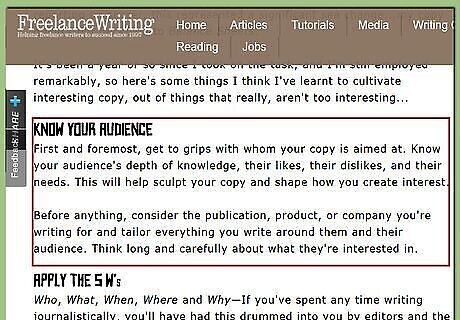
Always keep your audience in mind. When you begin to plan out an article, it's absolutely critical that you think about who will be reading it. Your audience will determine what kind of questions you should be addressing and what kind of language you should be using to answer them, so you can't skip this step! Think about how much your audience already knows about the topic. If it's geared towards novices, you will need to walk them through the material step by step and provide lots of background information. If it's geared towards people who are knowledgeable about the field, you will need to provide a more in-depth analysis and maybe utilize some industry jargon. If you know exactly who your audience is, you can make your writing serve a purpose. Always aim to solve a specific problem that your audience is experiencing with each article.
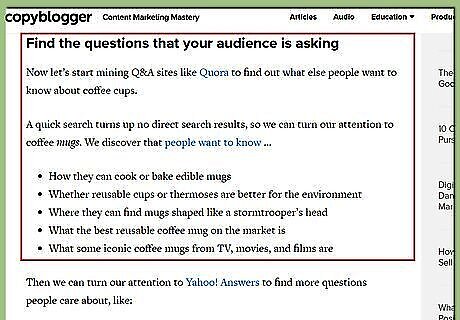
Ask interesting questions. You may think that the topic you have to write about is boring and that there's simply no way to write an interesting article about it, but that's not true! You can find an interesting way of approaching any subject if you simply ask the right questions about it. Take a moment to brainstorm questions that you have about your topic. For example, if your topic is thunderstorms, you may be wondering what locations have the most thunderstorms, why some places have more thunderstorms than other places, and what kind of damage a thunderstorm can cause. These are all great places to start for your article. Make sure the questions you're asking are interesting to other people, not just you. Try typing your keywords into major search engines to find out what people are asking about your topic on social media or forums. If people want to know about something, they will find your article interesting.
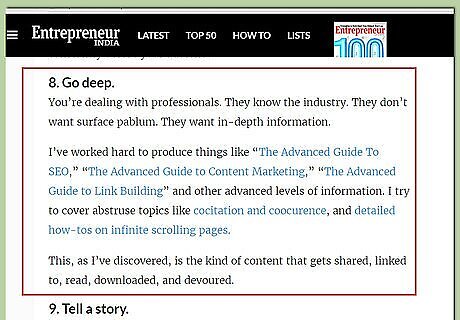
Provide new information. In order to make your article interesting, it's important that it be unique.You should aim to provide your audience with information that they can't get anywhere else whenever possible. Even if you know everything there is to know about your topic, it's still important to do research so that you know what else has been published on your topic. If you write an article that repeats information that is available in another article (even if this was not your intention) it will not be as interesting. If you can't come up with a completely new topic, try digging a little deeper into topics that have already been covered by others. Look for questions that the other articles failed to answer or angles that they didn't cover and make these the focus of your article.
Writing Compelling Content
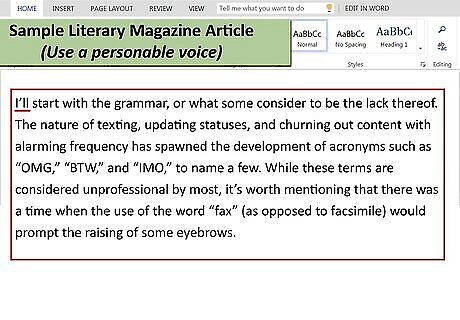
Use a personable voice. The voice of your article will depend on many different factors, including your topic and whether you are writing on behalf of a company or yourself. No matter what kind of article you are writing, however, it's important that you use a personable voice that sounds like a human, rather than a robot. If you are writing for a company, they probably have a manual that outlines what kind of voice they want you to use in your articles. If you ever have any questions about what is appropriate for your article, be sure to ask your editor or supervisor. While this isn't appropriate for every kind of article, using the first person pronouns "I," "me," and "my" can help your writing sound much more personable. Avoid using the first person plural pronouns "we," "our," and "us," even if you're trying to write on behalf of an entire company. This does not sound nearly as personal. If it's appropriate for your article, express emotions and opinions. Readers will appreciate the sincerity that this brings to your writing. If it is appropriate for your industry, consider telling a joke or making a reference to a current event. This will help your reader connect with you.

Answer all the questions. When writing your article, be sure to think about whether you have answered all of the main questions: who, what, when, where, why, and how. An article that leaves one or more of these questions unanswered will not seem complete. You may find it helpful to write an outline to help you keep track of the answers to these various questions. Whether you do this or not, it is a good idea to confirm that you have thoroughly answered each question during the editing process. Keep in mind that some of the questions will require more elaboration than others, depending on your topic. For example, if you are writing an article about cooking, you will probably devote the most space to discussing how to prepare the meal and what ingredients are needed.
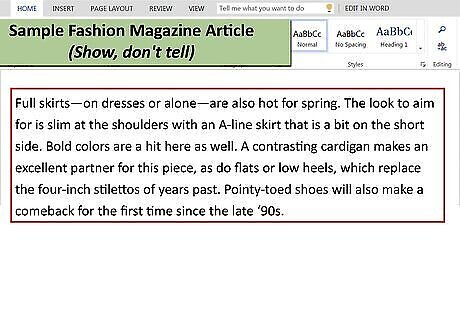
Show, don't tell. To make your writing as interesting as possible, use language that allows readers to come to their own conclusions, rather than simply stating the conclusion for them. This will help readers feel as if they are experiencing the situation you are describing. For example, if you are writing an article about your favorite travel destination, consider describing the white sand, the sparkling blue water, and the warm sun instead of just saying that the beach is beautiful. This technique works better for some topics than for others, so don't feel that you can never tell. For example, technical articles probably require more telling than showing.
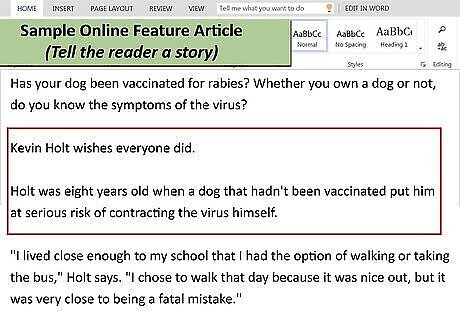
Tell the reader a story. People love to read a good story, so try to incorporate one into your article if you can. Even if you can't think of a way to tell a complete story, you can incorporate storytelling techniques into your article to make it more interesting. Foreshadowing can add interest to your story. Consider giving your readers hints about what is to come in the title or opening sentences of your article. For example, if you are writing an article about a new business that opened in your town, you might foreshadow information about a major setback that occurred along the way by saying something like, "The owner never anticipated that she would face as many obstacles as she did." Readers will get hooked faster if you start your article in the middle of the action, rather than by providing background information right away. Try to use suspense to keep them guessing about what will happen next whenever you can. Most great stories have some kind of conflict, so make sure this comes through in your writing. For example, if you are writing about a new apartment complex that is being built, it's much more interesting to include opinions from people who are both for and against the project than to simply state that the project is moving forward.
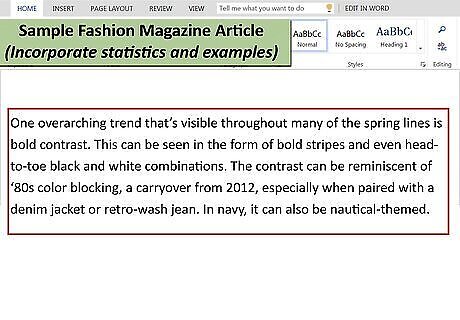
Incorporate statistics and examples. To help readers understand the importance of the information you are providing, it helps to be as specific as possible. This means providing hard data and concrete examples to support your writing whenever possible. For example, if you are writing an article about the prevalence of a disease, it would be helpful to include specific figures regarding how many people have been infected, the mortality rate, and how these numbers have changed over time. Even if your article does not lend itself to statistics, you can engage readers by providing specific examples of the impact of a certain situation. For example, if you are writing an article about dog training, you might include specific information about unwanted behaviors that are common in dogs who have not been trained.
Making Your Article Reader-Friendly

Write a compelling title. Whether your article is published online or in print, readers will decide whether or not they want to read it based on its title. On average, only 25% of people who read the title of an article actually start reading the article, but a good title can improve your odds. Make sure it matches the article content. Readers will not appreciate it if they start reading your article because they thought it would be about one topic, only to find out that it's about something else entirely. Make sure it is easily understandable and unambiguous. Avoid using words that have multiple meanings or could be misunderstood. Keep in mind that readers will not spend much time trying to decipher your title. Make it as specific as possible. Instead of writing "How to Decorate a Room," consider something like "How to Decorate Your Living Room Like a Professional for $200."
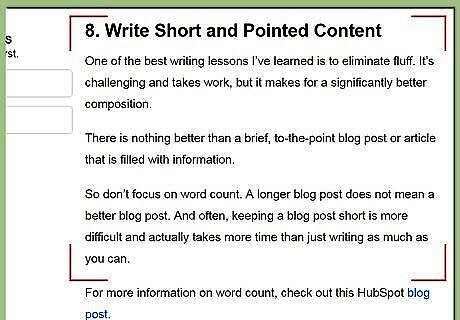
Avoid intimidating readers with too much text. Readers do not like to stare at a long block of text, so be sure to break it up to make your content seem more manageable. Most readers will skim an article rather than reading it in its entirety, so keep this in mind when formatting your work. Readers typically find numbered or bullet pointed lists very easy to read. If you can't make a list, consider breaking up your article into different sections using subtitles. Make sure readers can find the answers they are looking for quickly. This may mean bolding the most important information or making sure your subtitles are very specific.
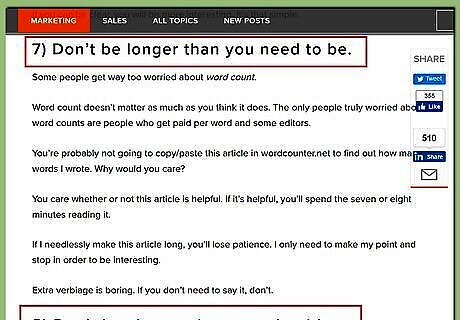
Choose the right length. There is no hard and fast rule for choosing the best length for your article, but it should be long enough to provide all of the important facts, but short enough that your audience does not get bored before finishing it. When deciding how long your article should be, think about who your reader is, how much information they will want, and where your article will be published. Make sure you have completely addressed your topic. If there are questions that have been left unanswered, your article is too short. Make sure you are not repeating yourself or writing sentences that don't add any important information to your article. If you are, you need to cut back.

Keep it clear and simple. Your article should be extremely easy for your reader to understand. In order to achieve this, use simple language and short sentences. This doesn't mean you can't be descriptive, but never sacrifice the clarity of your sentence for flowery language. Be as specific as possible. When you talk in general terms, you run the risk of losing clarity. It helps to offer examples and descriptions whenever possible. For example, instead of writing, "There are a lot of different birds in this area," consider writing something like, "Birdwatchers come to this area to admire the many different species that live here, including robins, blue jays, cardinals, and doves." When editing your work, be on the lookout for words that are not adding any additional information and get rid of them. For example, if you wrote, "People love this city for the simple reason that it has so much to offer," you can change it to "People love this city because it has so much to offer" without losing any of the meaning of the sentence. Don't feel like you need to use long or fancy words to sound interesting. This kind of language can make your writing more difficult to understand, so stick with the simpler word when in doubt. It's a good idea to think about your reader when determining how complex your language should be. If you are writing for a general audience, try to write at or near a 9th grade reading level. If you are writing for a more specialized audience, adjust the complexity of your writing accordingly. If you're not sure what reading level your article is, you can try running it through one of many free online reading level calculators.

Consider adding other media. People enjoy reading articles that contain more than just text. Look for ways that you can incorporate images or graphics into your article. The additional media should enhance your article and make it easier for people to understand the information you are presenting to them, so make sure they are clear and relevant. Add photos that will help your reader understand what you are talking about in your article. If you are talking about numbers, consider adding a chart or graph to illustrate the data. This will make it much easier for readers to absorb. People also find videos very helpful, so incorporate one into your article if you think it is relevant.

Edit and revise your work. No matter what you are writing, it's always a good idea to write a rough draft, edit your work, and then write your final draft. Some people find it helpful to start with an outline before they begin writing the first draft as well. Whatever process works best for you is fine as long as you edit for grammar, spelling, and style. Some people find it helpful to just write without worrying about spelling or grammar for their first draft. This is fine, as long as you are very thorough in your editing process and correct any errors you may have made. Read through your article very slowly so you will be more likely to catch typos and misused words. Be on the lookout for any sentence that seems too long or clunky. If it sounds a little confusing to you, chances are it will sound very confusing to your audience. If possible, have someone else read over your work and give you feedback. It's much easier for someone who did not write the article to pick up on potentially confusing verbiage. Once you have self-edited your work or had someone else edit it for you, write your final draft, making sure to copy edit it for errors one last time before submitting.















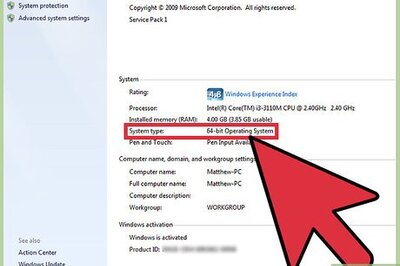



Comments
0 comment